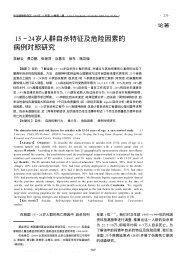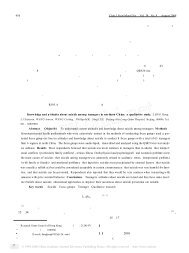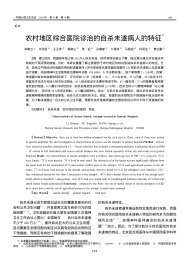Attitudes Toward Suicide Among Chinese People in Hong Kong
Attitudes Toward Suicide Among Chinese People in Hong Kong
Attitudes Toward Suicide Among Chinese People in Hong Kong
You also want an ePaper? Increase the reach of your titles
YUMPU automatically turns print PDFs into web optimized ePapers that Google loves.
Lee et al. 567<br />
The revised version of the <strong>Ch<strong>in</strong>ese</strong> At- nese University of <strong>Hong</strong> <strong>Kong</strong> to their<br />
titude <strong>Toward</strong> <strong>Suicide</strong> Questionnaire–<strong>Hong</strong> friends and relatives. Informed consent was<br />
<strong>Kong</strong> (CASQ–HK, available upon request) obta<strong>in</strong>ed from the participants and confiden-<br />
consists of 98 items. It was pilot-tested with tiality and anonymity were assured. A total of<br />
96 <strong>in</strong>dividuals of varied sociodemographic 746 and 480 questionnaires were collected,<br />
background <strong>in</strong> August 2004. Further revi- respectively. The overall response rate was<br />
sions were then made so that the items would 81.7%. Statistical analysis was carried out<br />
convey their <strong>in</strong>tended mean<strong>in</strong>gs effectively.<br />
The f<strong>in</strong>al version of the CASQ-HK consists<br />
of three parts. Part A is composed of 73<br />
with SPSS 13.0 for W<strong>in</strong>dows.<br />
statements about attitudes toward suicide on<br />
a 5-po<strong>in</strong>t Likert scale (1-greatly agree, 2-<br />
RESULTS<br />
agree, 3-neutral, 4-disagree, 5-greatly disagree).<br />
Part B <strong>in</strong>cludes 12 statements about<br />
Sociodemographic Characteristics<br />
12 difficult scenarios. Respondents were The demographic distribution of re-<br />
asked on a 5-po<strong>in</strong>t Likert scale (5–def<strong>in</strong>itely spondents is shown <strong>in</strong> Table 1. The mean age<br />
consider, 4–very likely to consider, 3–probably of males was 36.3 years (SD = 15.2) and for<br />
consider, 2–probably not consider, and 1–def<strong>in</strong>itely females, 31.8 years (SD = 13.9). There were<br />
not consider) their likelihood of consider<strong>in</strong>g more males than females and most respon-<br />
suicide <strong>in</strong> those scenarios. Part C was composed<br />
of 13 items about sociodemographics<br />
dents reported no religious affiliation.<br />
and the presence of serious suicidal ideation,<br />
previous suicidal attempt, and hav<strong>in</strong>g known<br />
Reliability and Factor Analysis<br />
someone who attempted or committed sui- The Cronbach’s alpha of the CASQcide<br />
previously. Approval for the study was HK is 0.852. Part A of the CASQ-HK was<br />
obta<strong>in</strong>ed from the research ethics committee factor analyzed us<strong>in</strong>g the pr<strong>in</strong>cipal axis facof<br />
The <strong>Ch<strong>in</strong>ese</strong> University of <strong>Hong</strong> <strong>Kong</strong>. tor<strong>in</strong>g method with varimax rotation. A n<strong>in</strong>e-<br />
Ow<strong>in</strong>g to the sensitivity of the topic, several factor model, which together expla<strong>in</strong>ed 36.1%<br />
hotl<strong>in</strong>es for help-seek<strong>in</strong>g were provided at of the total variance, emerged as the most <strong>in</strong>-<br />
the end of the questionnaire. terpretable and could be considered an ade-<br />
Although we renamed the CASQ-HK quate representation of the data provided by<br />
as an <strong>in</strong>strument that exam<strong>in</strong>ed attitudes to- the sample of respondents. In Table 2 the<br />
ward life and death, our attempts to approach items with load<strong>in</strong>gs of more than 0.35 on any<br />
several organizations for data collection, such of the factors are displayed. The n<strong>in</strong>e factors<br />
as schools, corporations, and old age homes, perta<strong>in</strong>ed to negative appraisal, stigma, sui-<br />
were uniformly refused. Accord<strong>in</strong>g to the ad- cidal spectrum, fatalism, social change, sup-<br />
m<strong>in</strong>istrators of those <strong>in</strong>stitutions, they were port, contagiousness, sympathy, and function.<br />
concerned that their study could evoke sui- Sixteen items (available from the authors<br />
cidal ideas among their students, staff, or <strong>in</strong>mates<br />
that they did not know how to handle.<br />
Survey Participants<br />
upon request) did not load on any factors.<br />
Variation of <strong>Attitudes</strong> <strong>Toward</strong> <strong>Suicide</strong><br />
Items on each of the n<strong>in</strong>e factors were<br />
We eventually recruited a convenience scored from 1 to 5, with a higher score <strong>in</strong>disample<br />
that was composed of <strong>Ch<strong>in</strong>ese</strong> people cat<strong>in</strong>g stronger disagreement. Items with op-<br />
born and liv<strong>in</strong>g <strong>in</strong> <strong>Hong</strong> <strong>Kong</strong>. One thouposite mean<strong>in</strong>gs were reversely scored. These<br />
sand questionnaires were distributed to staff scores were tested us<strong>in</strong>g two-tailed t tests and<br />
members of a medium-sized trad<strong>in</strong>g com- ANOVA at the significance level of 0.05 to<br />
pany. Another 500 questionnaires were dis- compare differences across demographic sub-<br />
tributed by n<strong>in</strong>e student helpers of The Chi- groups (Table 3). Although males showed a<br />
493
















